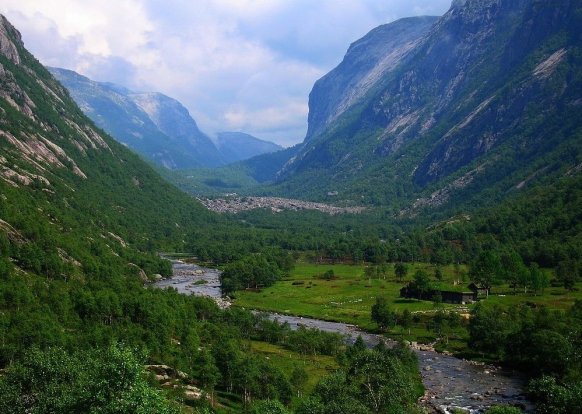Question: What does Norway have in common with Scotland?
Answer: Much more than those of us attending a talk by Scots-born ecologist, Duncan Halley, expected.
Duncan lives and works in Norway for the Norwegian Institute for Nature Research (NINA). He kept a large group of us engrossed in the Scottish Natural Heritage office in Edinburgh recently, with his fascinating comparisons between Scotland and Norway.

Oslibakken Rogaland today,. Look closely and you will see an orange ‘x’ near the centre of the image. This is where the image below, dating to 1911, was taken from. All you would see from it – or anywhere near it – today would be trees. Photo courtesy of Erlen Tøssebro

It turns out that coastal southwest Norway shares a similar landscape, climate and geology to Scotland. In particular, the land in south-west Norway has a similar history, with livestock grazing, muirburn, tree felling for timber and fuel, and wide-spread peat collection all playing key roles. Because of all this, previously forested areas had mostly been transformed to open moorland by the Bronze Age, and remained so up until modern times – once again, a similar story to Scotland.

A photo showing peat cutting – which could have been an accurate depiction of Norway any time between the 1920s and 1950s before regeneration of woodland took hold.
But the two countries have radically diverged over the last 100 or so years. Norway has seen tree regeneration on a massive scale from the late 19th century and especially since the 1950s. Forest cover in southwest Norway increased by 55% from 1963 to 1993 alone. Much of this regeneration is occurring on wet peaty soils formed during the deforested period.
And amazingly, this isn’t through a huge government programme. It’s mainly natural regeneration, resulting from the many landless Norwegians emigrating to the U.S. from the mid-19th century through to the early 20th century. For those that stayed on farming, this left just owner-occupiers who didn’t farm the land as intensively.
Today, most farmers aren’t full-time and on average only earn 29% of their income from their farms. Farms may include parents, adult children and spouses – with many family members working off the farm. As well, family who live off the farm may come home to help during the harvest.
In general, properties are much smaller: the average area of arable land per holding is about 15-20ha.
But unlike Scotland, most holdings also include around three times the amount of productive woodland as arable land. Owner-occupation is strongly encouraged by government policy, and 97% of woodlands are privately owned.
There are still 450,000 sheep in southwest Norway, but reduced grazing has changed moorland to woodland in many places. Hunting is also very widespread in Norway, and each property is given a quota of deer to harvest; this also plays a part in protecting woodland. Research in recent years found that there wasn’t enough food for the deer and, as a result, their average weight was declining. Road traffic accidents involving deer were also increasing. The quotas appear to be helping so far, with stag weights in response to the harvest up by 5 to 10% this year.
The regenerated woodlands also improve the soil, as trees shed leaves, which then decompose and keep soils healthy. All of this has resulted in increased biodiversity with species like ring ouzel, bluethroat and brambling (rare residents or visitors to Scotland) now commonly associated with scrub and treeline vegetation in Norway.

All trees at Sagvatnet are less than 150 years old. Most are under 100 years old. All are naturally regenerated.
Duncan also gave us some fascinating insights into the Norwegian love of the outdoors – for example, there are 398,884 cabins and summer houses in Norway – or 1 per 12 inhabitants. As well, proportionally, the membership of the hikers’ association is higher than the largest membership organisation in the UK (RSPB), and students, beginning in kindergarten, go on regular outdoor trips as part of the curriculum.
Further information – the entire talk that Duncan delivered in Silvan House was also given at the Scottish Parliament the previous evening. It is available to view online at http://www.nina.no/Aktuelt/Nyhetsartikkel/ArticleId/3941



You must be logged in to post a comment.